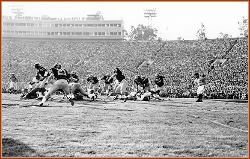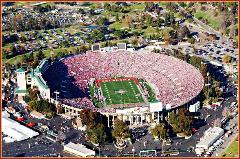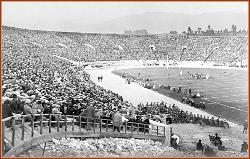



Peden Stadium is a football stadium on the banks of the Hocking River in Athens, Ohio. It has been the home of the Ohio Bobcats football team
since 1929, and today has a capacity of 24,000. Peden Stadium is the oldest college football venue in the Mid-American Conference and among
the oldest in the nation.
The facility, originally known as Ohio University’s Athletic Plant, was built at a cost of $185,000 and was completed in 1929. The stadium originally
sat only 12,000 fans with grandstands on each side of the playing field. The first ever game at the venue featured a 14-0 Bobcats victory over
archrival Miami University in front of a sellout crowd. Following the retirement of legendary Ohio football coach Don Peden in 1946, the stadium
was renamed Peden Stadium.
Numerous renovations and enhancements have helped Peden Stadium to become one of the most attractive venues in the Mid-American
Conference and Division 1-A football, allowing it to earn the nickname "The Wrigley Field of College Football". In 1986, the seating capacity was
increased to 19,000 with the addition of two new grandstands in the north endzone. Four years later, a five story tower, called the Peden Tower,
was added to the stadium's west side. Today, this state-of-the-art facility houses press boxes, gameday suites, football offices, athletic training
facilities, team meeting rooms, a recruiting lounge, a ticket office, the football locker room, and Ohio Athletic's academic services and compliance
departments. In 1999, a new 10,000 square foot strength and conditioning center called The Carin Center was added to the ground level of
Peden Stadium.
Some of the most extensive renovations, though, occurred after the 2000 football season. This $2.8 million project removed the track, lowered
the stadium's playing surface by 10 feet, and increased the seating capacity to its current mark of 24,000 with the addition of lower-level,
bleacher-back seats collectively called the Phillips Club. Also during this renovation, permanent seating for Ohio's world famous marching band,
The Ohio University Marching 110, was created in the north end zone and Victory Hill, a grass berm for overflow seating, was added to the south
end of the field. In 2002, the natural grass playing surface at the stadium was replaced with FieldTurf, and in 2003 a new Daktronics video
scoreboard was added to the south endzone. Following the completion of the 2004 season, the stadium underwent another large project that
renovated/expanded the stadium's athletic training facilities, added a large team auditorium, improved position meeting rooms, expanded the
recruiting lounge, and enlarged office space for the football coaches.
Peden Stadium brought in its largest crowd on September 9, 2005, when 24,545 fans were in attendance to watch the Bobcats defeat the
University of Pittsburgh Panthers 16-10. The game was televised on ESPN2 and was the first home game for Ohio Coach Frank Solich.
In addition to serving as the home of Ohio Bobcats football games, the stadium has been used for several other purposes. It has hosted
numerous local high school football games and high school state playoff games. In addition, the stadium serves as the home of Ohio's annual
homecoming "Yell Like Hell" pep rally and has been the site of several concerts.






